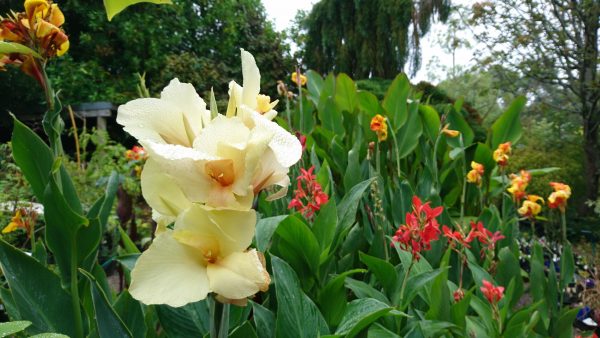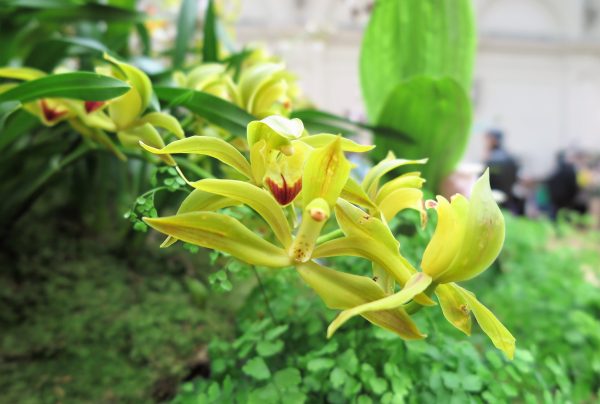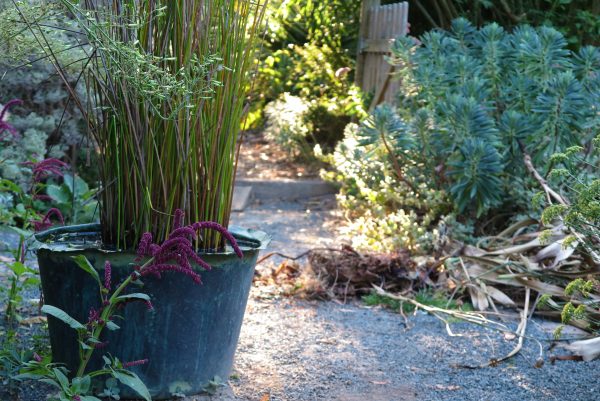There’s a definite trend towards the exotic garden.
Or even just the exotic border. You don’t have to rip your whole garden out and re-plant with banana palms – you can create a mini-jungle atmosphere in a sheltered corner.
1) An exotic garden can work with your architecture
Exotic gardens in the UK date back to Victorian and Edwardian times when plant hunters scoured the world. They brought exotic plants back to Britain, the United States and Australia.
And Victorians moving around the world ‘for the Empire’ took their architecture and their gardens with them.

This is a small town garden behind a Victorian terraced house. Exotic works perfectly.
So an exotic garden or border can also be described as ‘traditional’ in the UK, especially if you live in a Victorian or an Edwardian house.

Exotic shapes and colours at the Salutation in Sandwich. It’s an Edwardian house, built in 1911.

A front garden in Whitstable designed by Posy Gentles. Strong shapes and colours make this an exotic contemporary look.
Modern houses and extensions also work well with exotic plantings because the strong sculptural shapes and bright colours contrast well.
2) Pack your exotic garden with plants in layers
I interviewed Australian TV gardening expert Stephen Ryan on how to create an exotic garden in a temperate climate. He has a nursery near Melbourne called Dicksonia Rare Plants.

Stephen Ryan in his garden. It is all plants, paths and ponds. There are no lawns in the jungle! The big leafed plant on the left is Tetrapanax papyrifer, which is fairly hardy in UK winters.
Melbourne is hotter than the UK in the summer, but has some very cool winters, so many of the plants in Stephen’s own garden would work in the UK or North America.
The garden is called ‘Tugurium’, which is Latin for hovel. He bought the one-acre of land with compensation money for losing all his possessions in ‘the 1983 fire’. This was a devastating forest fire that swept through this part of Melbourne, taking 300 lives and destroying much property.

Tugurium – a house and garden created from a bare patch of land. Stephen is proud that ‘nothing ever leaves the propery’. Everything is recycled, composted and waste water is reused.
There was no house or garden – not even any topsoil – when he moved in. He created the garden from scratch. It regularly featured in ‘Gardening Australia’ when Stephen hosted the programme.
Create a jungle ‘canopy’
Everything was created on a tight budget, so he was only able to build a small house. A neighbour commented that it was a shame that such a ‘hovel’ had been built so close to him. So Stephen named the house and garden ‘Tugurium’ as his response.
Stephen’s one acre garden is packed with plants. He actually holds four National collections in the space.
Trees and tall shrubs, many of them hardy in winter, create an upper ‘jungle canopy’. They are underplanted with ferns and smaller plants, just as would occur naturally in the jungle.

Palm trees, cordylines and ferns are planted close to Stephen’s house, creating a jungly feel. The palm is is Livistona australis, the most southern-growing palm (in the Southern hemisphere, this means the most tolerant of cool winters). People report it growing -quite slowly – if well sheltered in the UK. The Trachycarpus fortunei palm tree is considered more reliable in cool climates.
Go for big borders and lots of layers to get the jungle look.
3) Find the tropical corner of your garden
Stephen says that every garden has its own patches of micro-climate. Experiment to see where less hardy plants do well. It’s often much warmer near the house, for example.
‘Don’t be afraid to experiment and see what works,’ he says. ‘The worst that can happen is that a plant dies, which will create something that’s very precious in a garden.’ He pauses. ‘An empty space.’

Puya chilensis in Stephen’s garden. This will just about survive outside all year in warmer parts of the UK, but you might want to keep it in a pot and bring it in in winter. Too spiky for fleece! But just experiment – you may have a magically sheltered spot. Puya chilensis is called the ‘sheep eating plant’ as it traps sheep in its sharp spikes. They die and decay and the plant feeds off the decay. Maybe not a plant for those with small dogs, though Stephen has two who have survived fine.
4) Choose plants with big leaves and/or strong shapes
Stephen recommends mahonia as a good shrub for an exotic look. Forget about its suburban reputation. Combine it with bamboos, ferns and other jungly-look plants.

Mahonia and bamboo get jungly together in Stephen’s garden.

Fatsia, seen here against Stephen’s house, is another much maligned shrub which will give a tropical look in a temperate climate.

The totally tropical look in a friend’s garden in Australia: cordylines, tree ferns, rhododendrons and conifers create upper and middle layers. All except the tree fern are hardy in most parts of Britain, and tree ferns do fine in the right spot and with the right care.

Cordylines for sale in Faversham market, Kent. The green varieties are hardier than the red.
5) Combine lush planting with bright colours
Dahlias originally came from Mexico, but are now considered quite ‘traditional’ in English gardens. Take them back to their colourful roots by using them to create exotic garden beds.

Dahlia ‘Mel’s Orange Marmalade’ in the exotic garden at the Salutation in Kent, along with cordylines, Musa banana palms and ricinus.
And cannas will also look good in the exotic garden. Like dahlias, they are reasonably hardy in most parts of Britain, provided you protect their roots/rhizomes with a thick layer of mulch in autumn.

Canna ‘Stephen Ryan’ at his nursery near Melbourne.

Canna ‘Cleopatra’ at Stephen Ryan’s nursery.
Begonias and fuschias are also flowers we take for granted. They,too, can look remarkably exotic in bright colours and the right context.
6) Keep frost-tender exotics in pots
Some exotic plants won’t survive a Northern hemisphere winter, but will do well in pots outside in the summer. You can bring the pots in to an unheated but frost-free greenhouse or conservatory, or protect them with fleece in a sheltered spot.

Aeoniums have a wonderfully tropical feel. Stephen grows them in his garden. If you live somewhere mild, you can try this. Or keep them in pots and protect them in the winter.

Cymbidium orchids will also probably be happy to live on your terrace in a sheltered spot during the summer. In winter, they need to be protected from frost, but cool (8-10 degrees C) and in a light place.

A pot pond with planting in Stephen’s garden. The plant to the right is euphorbia characias – many of the euphorbias have a jungly look to them. This is a Mediterranean plant
7) Contrast leaf shapes
Vary your leaf shapes, contrasting big sculptural leaves with tall slim plants like bamboo, advises Stephen. Bamboo grows well in the UK – sometimes too well. Make sure you don’t buy the spreading type as it will take over your garden.

Big sculptural shapes contrast with the slim stems of bamboo in the exotic garden at The Salutation.
8) Visit exotic gardens near you
Christopher Lloyd re-started the trend towards exotic gardens and borders when he ripped out his mother’s rose garden in 1993. He replaced it with the ‘exotic garden’. It’s planted with cannas, dahlias, verbena bonariensis and the relatively hardy banana palm Musa basjoo.

The exotic garden at Great Dixter – the plants tower over your head. I love the way the light streams in, as this was a particularly sunny day.
Henstead Garden in Suffolk is also an ‘exotic garden’, named as Garden of the Year by Alan Titchmarsh in 2015.
And the RHS has several exotic garden areas, such as those at RHS Rosemoor in Devon.
We’ve even got an ‘exotic garden’ as one of our open gardens on the Faversham Open Garden & Garden Market Day on 25th of June. Mary Mackay, who owns it, says she’s ‘not really a gardener’, but she just loves exotic plants and leaf shapes.

Mary Mackay combines cardoons, cordylines, bamboo and hostas for a jungly effect. Her garden is just a small town garden.
Lastly, pay a visit to a good exotic plant nursery. My favourite is Architectural Plants, which describes itself as the’ home of the tropical and jungly in both big and small plants.’
I find Architectural Plants an inspiring nursery to visit. Plants and arrangements are beautifully presented.
7) Read the best books and blogs on exotic gardens
Before he died, Christopher Lloyd started his last book, Exotic Planting for Adventurous Gardeners. It was finished by his friends, and is considered one of the best books on exotic gardens you’ll find.
Note: these are associate links to Amazon, which means you can click through to buy. If you do, I may get a small fee but it won’t affect the price you pay.
And Will Giles’ book Exotic Plants for Temperate Climes is rated highly. It’s a useful directory of plants that will survive in your garden but will add an exotic touch.
If you’re interested in growing exotic fruit and vegetables, A Taste of the Unexpected by Mark Diacono won the Guild of Food Writers’ Book of the Year in 2011.
And, although it looks as if it may be only available second-hand or on Kindle, Architectural Plants by Christine Shaw is worth getting your hands on.
One of the most popular blogs in Britain is Alternative Eden, an account of an exotic (clearly middle-sized) garden in Luton. Mark and Gaz both have ‘busy professional lives’, but travel as much as they can. Their garden is influenced by their travels – they bring ideas back and try them out. They have a devoted following.
Or you could follow Clive from Alternative Plantings, who is creating a tropical garden in South London for opening to the NGS on September 3rd, 2017.
8) Rock the exotic garden inside your home
Phalaenopsis orchids, bromeliads, cacti, air plants…

Bromeliad ‘air plants’ that don’t need to be planted in water. Aldo Airplants hanging on a rail at the RHS Spring Plant and Orchid show.

Phalaenopsis orchid ‘Surf Song’ at the RHS Spring Plant and Orchid show.

Cacti from Ottershaw Cacti at the RHS Spring Plant & Orchid show.
The ‘jungle’ look is very popular for indoor plants – strong, structural shapes and bright colours look good in modern interiors.
Let me know of any good exotic gardens, nurseries or books near you, and I’ll add them to the list.
And do join us every Sunday morning – subscribe by email in the box on the top right. Thank you!
Pin this post for later:
The post How to create a brilliant exotic garden in a cool climate appeared first on The Middle-Sized Garden.
from The Middle-Sized Garden http://www.themiddlesizedgarden.co.uk/how-to-create-a-brilliant-exotic-garden-in-a-cool-climate/

No comments:
Post a Comment